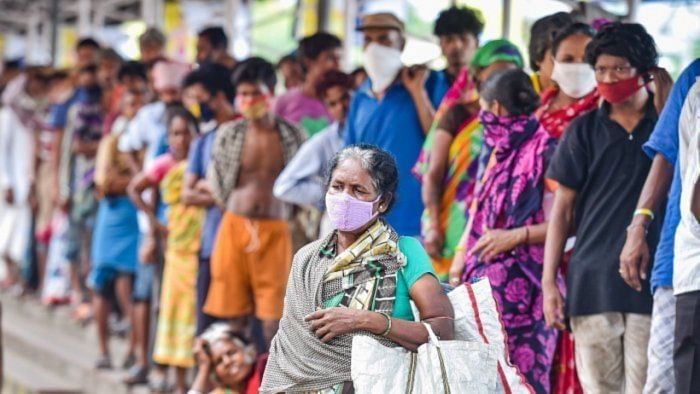
In international policy forums, there is puzzlement on India’s stance on a few issues. Firstly, why is India so strongly backing Russia, especially when it is threatening to use the N-weapon?
Secondly, friends who have always admired its democratic and diverse foundations, are asking if India is getting autocratic and weakening its institutions. There are doubts being raised regarding minorities and their security.
Thirdly, and that’s what we discuss here, is an immediate worry: why is India making an issue of Trade-Related aspects of Intellectual Property Rights (TRIPS) waivers when it was a broken health system that took 5 million lives of the 56 million who got infected by Covid-19?
A new treaty is being drafted by the World Health Organisation to handle the next pandemic. Covid-19 and its devastating impact on world health and the international economy is widely acknowledged.
The international leadership was caught unawares, which led to an early fumble in the declaration of the pandemic. Then followed an unequal access to testing, diagnostics and vaccines; an ill-thought out and rather draconian lockdown and an economic recovery design that could have been better handled.
Ever since the dreaded flu during
the First World War, we have seen a recurrence of epidemics with unfailing regularity. The first was the Asian fever, which was quickly followed by the Hong Kong flu.
The deadly cholera did not end while we saw the severe acute respiratory syndrome (SARS) make its appearance.
Starting in the eighties, we grappled with HIV/AIDS, swine flu, the middle east respiratory syndrome (MERS), Zika and Ebola. However, none of this was as devastating as Covid-19. If the world now does not get its collective act together, the next tragedy will be dire.
We haven’t seen the end of pandemics and another might very well be around the corner. International cooperation and multilateral collaborations are critical to the world’s future. However, what each country must watch out for is an easy decline into protectionism and the age-old simplistic, over-regulatory capture.
The signs are ominous and countries like India are pushing hard for TRIPS waivers and price caps. These have seldom worked in the past and there is no reason they will work again, except in distorting innovation that is key to handling future crises.
Given the mortality and morbidity they have suffered, India and others must improve their health infrastructure and train a workforce that was simply unprepared, both in numbers and by way of training.
Two-thirds of the population lives in rural areas while three-fourths of healthcare facilities are in urban centres. Only about a third of the population has any financial protection against illness and the largest cause of chronic poverty remains one single episode of illness. What is ironic is that the federal budgets for health
have been reduced in real terms over the last two years.
Unable to handle the burden, health policy has moved back and forth between compulsory licensing and price caps. This has not only resulted in a huge supply-side problem and acted as a dampener to innovation, but also leads to an uncertainty in policy that pushes foreign investment away and domestic investors getting discouraged.
New product development does not happen enough. And, ironically, healthcare costs for the poor continue to go up.
The history of research and development of vaccines has a lesson for countries like India. Both the private sector and the public sector gave up on all cutting-edge research and development on vaccines and viruses back in the 1970s.
As a result, we found ourselves in a situation when we had to fight all these epidemics with our hands tied. Transfers of technology were difficult and foreign supplies of medicine and diagnostics were expensive.
A vibrant climate of discovery and innovation needs a consistent policy that incentivises new drug development and ensures consistency in property protection and pricing.
Today, what is important is to increase diagnostic capabilities, the number of beds, ICUs and ventilator-equipped clinics and not repeat the mistake of going back to compulsory licensing, price caps of drugs and a non-economic control of diagnostic prices.
It is unfortunate indeed that India, a country that was arguing for multilateralism and openness in world trade, domestically has a tendency towards increased curbs in dilution of intellectual property rights.
India must urgently improve the numbers in its health workforce that is less than 11 per 10,000 against the WHO recommendation of at least 44.5 skilled healthcare workers per 10,000 population.
We have just about a million doctors for a 1.3 billion population and, even more scarily, less than 8,00,000 working nurses and midwives.
The Prime Minister has been rightly emphasising the need for more medical colleges and universities. However, even if we go ahead and meet the target of opening 157 new colleges and 57 nursing institutions, we will still be woefully short of the numbers we need in 2030.
While tuberculosis and diarrhoea remain big threats, causing about 1.5 million deaths together each year, Covid continues to linger. As existing heart diseases, diabetes cases and respiratory problems become bigger, it is also true that infectious diseases continue to be a major threat from across the borders.
The new challenge might not be Covid, but we are aware that new pathogens might come in from among unknown viruses in the wild that have not yet been tracked and tested. A new treaty is very much on the cards and is needed, but it should not recreate old problems.
(The author teaches Health Economics and Policy at the Indian Institute of Public Policy)